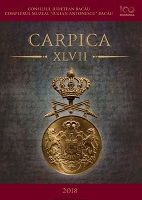Casa-Muzeu dedicată profesorului băcăuan Grigore Tabacaru
Museum-House dedicated to teacher Grigore Tabacaru from Bacau
Author(s): Dimitrie-Ovidiu BoldurSubject(s): Cultural history, Museology & Heritage Studies, Architecture, Regional Geography, History of Education, 19th Century, Pre-WW I & WW I (1900 -1919), Interwar Period (1920 - 1939)
Published by: Complexul Muzeal “Iulian Antonescu” Bacău
Keywords: Museistics; regional museum; Literary Athenaeum; Grigore Tabacaru; museum-house; cultural society; personality;
Summary/Abstract: Built in the middle of the 19th Century, the museum-house in Hemeius-Bacau is an architectural space where the local school functioned for well over a century. The son of priest and teacher Alexandru Tabacaru, Grigore Tabacaru was born in this edifice, which has been included on the list of Historic Monuments from Romania. One of the reasons behind declaring the building a historic monument was mainly due to the personality who first saw the light of day in this place, in the spring of 1883. Grigore Tabacaru outlined, through his contributions of scientific and educational role, to the memorial importance of such an establishment. A second reason is that the Tabacaru family setup a cultural society in Fantanele-Hemeius (1905). The society was endowed with a library, the purpose being that of „learning the village life” by having the villagers read „books corresponding to practical needs, as well as literary books”. The peak of community work was „Tabacaru’s School”, where the Teacher himself „would read to the peasants every Saturday night political, social, economic and cultural news from gazettes”. A last support point, in the logics of memorial interconnections, was the editing of the publication entitled „School. Pedagogic magazine drafted by the members of the primary education teaching staff. Fantanele-Bacau” (1905) – the editorial office of the periodical being housed under the generous roof of the same family. Thus, years later, at the initiative of teacher Petru Juverdeanu and a group of former students of the great Bacau pedagogist, a „museum-house” was setup in this edifice (1971-1972). Seen from outside, the building’s architecture is not an imposing one, that can be classified in one particular style. Functional, from the very beginning for the several tens of children over the years, it will become insufficient for the primary school classes in Hemeius village. The damage of the roof or resistance structure are significant. Still, we subscribe to the title of „museum-house” suggested in the 70s of the previous century by those who wanted to honour the work of one of their kind. Such an approach granted, and at the same time used the memorial value of the objects saved from Tabacaru family. But as with us, the Romanians, a miracle will not last more than 30 years… in the murky years after the „’89 moment” the „museum-house” of Hemeius received another „destination”. Although rightfully registered as „Grigore Tabacaru’s Memorial House, Hemeius” in the Historic Monuments List of 1992, the ground floor was leased starting with 1999. Although the building is considered to be „public property goods of the Romanian State”, everything that was gathered over the years in Grigore Tabacaru museum-house degrades with every passing year…
Journal: Carpica
- Issue Year: 2018
- Issue No: XLVII
- Page Range: 386-399
- Page Count: 14
- Language: Romanian

